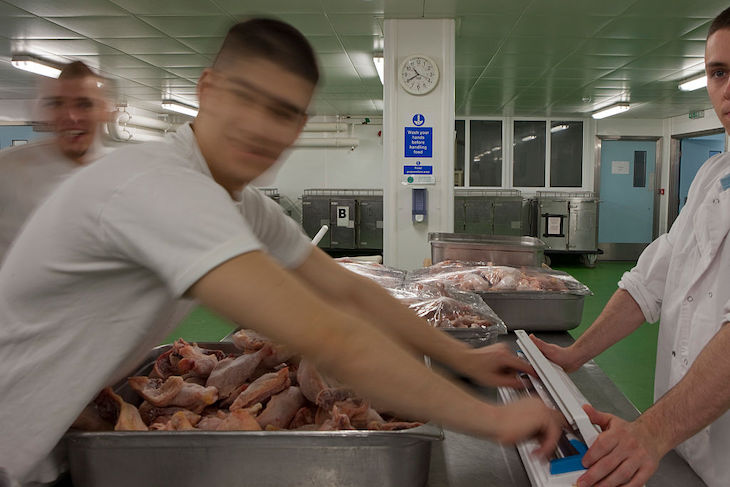After Hashem Abedi allegedly attacked three prison officers with hot cooking oil at HMP Frankland last weekend, there has been a crackdown on inmates using kitchens. Self-catering facilities have been suspended in separation facilities like the one that housed Abedi, the convicted terrorist who helped his brother plan the Manchester Arena bombing. This is a sensible approach, but this horrific incident cannot be allowed to overshadow the important work done in food education in prisons.
I’ve been working for prison food charity Food Behind Bars (FBB) for nearly four years, teaching in men and women’s prisons across the UK. Throughout my time there, I have come to understand that cooking is an aid to prisoners who are down the long road towards rehabilitation and release.
This horrific incident cannot overshadow the important work done in food education in prisons
I recently finished teaching a cooking course with FBB in HMP Downview, a women’s prison in Sutton, Surrey. We used cutlery knives and a few basic utensils, plus a motley crew of pots and pans that had certainly seen better days. The fire alarm may have accidentally gone off once or twice, sending prison officers running as we wafted tea towels at the smoke detector. Nevertheless, the women learned an array of dishes; sweet and sour chicken, Victoria sponge, lamb kofte, even a Biscoff profiterole wreath.
The women’s cooking knowledge varied massively. Some were used to the mass catering that comes with being a matriarch, others had never made themselves a meal. One woman couldn’t step near the oven as the heat triggered her PTSD after she was left to burn in a house fire. The keener cooks told me of meals they had made on their wings with pride, using self-catering facilities that were only available to inmates on lower-security wings, for those who had earned them. These classes offered distraction and respite from the punishing day to day schedule of life behind bars. A female inmate worked diligently in the class, quietly concentrating on arranging the fruit when making a galette. She later told me of the ‘peace’ she felt when making it, distracting her from the constant thoughts of her 14-year-old daughter, who had taken her own life while she was in prison.
The point was that, no matter their crime, no matter their experience inside, the concentration and skills shown when wielding a piping bag, making an omelette or seasoning a sauce was impressive and moving. The power of prison food education is not anecdotal; it can be quantified time and again.
It is not news that the prison system is in crisis. The UK has the highest reoffending rate in Europe, and an £18 billion annual reoffending bill. A 2024 report from the HM Chief Inspectorate of prisons wrote, ‘if we want to see less reoffending and fewer victims of crime, prisons must deliver on their purpose to protect the public by working with prisoners to help them prepare for their return to society’. Food education is part of this commitment to rehabilitation, with successful culinary education programs in prisons across the country.
FBB is headed by CEO Lucy Vincent and its head of food education Natalia Middleton. They facilitate teaching 250 men and women a year to grow and cook food. Vincent says that ‘the opportunity to learn how to cook or prepare their own food provides an important source of education, autonomy and normality for prisoners’.
It is not only the work of FBB that has shown the positive impacts of culinary education in prisons. A study conducted by Think Through Nutrition into the effects of nutrition in prison found that nutritional supplements reduced violent offences by 37 per cent. People often begin to roll their eyes when I compare the UK prison system with Scandinavian prisons, but the facts speak for themselves.
Scandinavian prisons boast prisoner self-catering, homegrown food and the lowest re-offending rates in the world. This is no accident. More public money is available to fund prisons and the culture encourages that everyone in society should have access to nutritious food. In Norway, for example, a place at Halden prison costs £98,000 per year, compared to the UK’s £48,774. In the UK, around 60 per cent of released inmates go on to reoffend within a two-year period. But in Norway the reoffending rate is only 20 per cent after two years. This is not to say that the only reason Scandinavia has so few re-offenders is simply because the food there is better. But this is reflective of the cultural belief that looks at prisons as rehabilitative, rather than solely punitive.
Nathaniel Mortley, or Natty can cook, was once an inmate at HMP Brixton. He enrolled and cooked in the prison restaurant The Clink, which provide culinary education and work in a functioning prison restaurant. The Clink’s 2023 impact report revealed they placed 52 per cent of their students in employment upon release, with Natty being one of them. In the years since, he has showcased his talents at The Greyhound pub in Peckham, south London. ‘Cooking inside gave me structure, confidence and showed me I had something to offer,’ he says. ‘We have to keep investing in food education in prisons. I’m living proof that a prison kitchen can transform lives, restore purpose and build futures’.
Teaching in prisons forced me to reassess my own prejudices of what I expected prisoners to be like. I was struck by the poor mental health, severe self-harm and familial chaos many prisoners experienced. I witnessed the kindness, intelligence and candour of inmates. But I was perhaps most surprised by the commitment of many to turn their lives around. To paraphrase prisons minister James Timpson: a third of prisoners deserve to be there, a third would be better off in mental health treatment and a third need not be there at all. What food education does is offers tangible steps to rehabilitation, with employment prospects at the end of that road. Now is the time to reinvest in it, not strip it back.







Comments